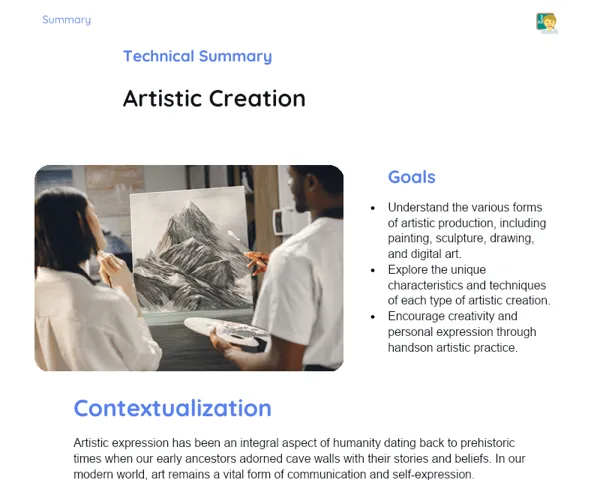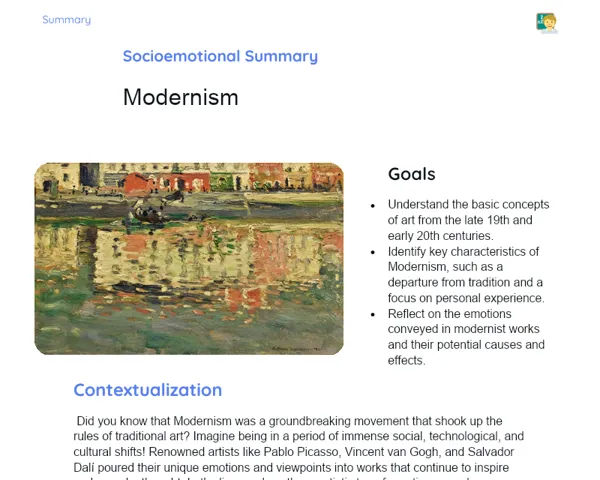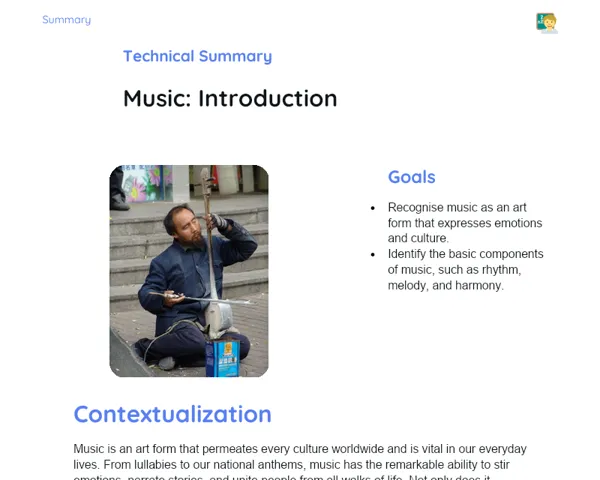Socioemotional Summary Conclusion
Goals
1. Explore the various forms of dance found in different cultures.
2. Appreciate the significance of movement as a core component of dance and artistic expression.
Contextualization
Did you know that dance is one of the oldest forms of human expression? From the time of our ancestors, people have used movement to narrate stories, celebrate milestones, and convey feelings. Today, many cultures across the globe boast their own traditional dances, each infused with unique meanings and distinct movements. Let's dive into these cultural gems and see how dance can enhance our understanding of ourselves and one another! 💃🌍
Exercising Your Knowledge
Definition of Dance
Dance is an artistic way of communicating that employs body movement—often set to music—to express feelings, share stories, and honour cultural traditions. It's a universal form of expression that bridges cultural and language divides.
-
Dance is an art form: It uses the body as a canvas to create and share beauty, emotion, and meaning.
-
Movement and music: Many dance styles merge precise movements with music to amplify the emotional experience.
-
Emotional expression: Dance provides dancers with an outlet to convey a broad spectrum of emotions—from joy to sadness—acting as a means of self-exploration and personal expression.
History of Dance
The journey of dance is extensive and diverse, tracing back to prehistoric times when it served purposes in religious ceremonies, celebrations, and as a form of communication. Throughout history, dance has evolved, adapting to various cultures and fulfilling roles such as entertainment and artistic expression.
-
Ritual origins: The earliest dances were often tied to spiritual rituals and sacred ceremonies.
-
Cultural evolution: Every culture has crafted its own dance styles, mirroring its identity and values.
-
Social impact: Dance has consistently played a vital role in society, whether fostering community spirit or serving as a medium for both personal and collective expression.
Elements of Dance
The building blocks of dance include movement, space, time, energy, and relationship. Each one plays a crucial role in shaping and interpreting a dance performance, adding richness and significance to the acts of movement.
-
Movement: Pertains to the physical actions performed by dancers, from subtle gestures to dynamic leaps.
-
Space: Involves how dancers utilise physical space, including directions, levels, and pathways of their movements.
-
Time: Concerns the rhythm, pace, and duration of movements, in sync with music or other sound cues.
-
Energy: Relates to the quality and intensity of movements, ranging from smooth and flowing to robust and vigorous.
-
Relation: Looks at the interaction between dancers and between performers and audiences, fostering emotional connections and storytelling through movement.
Key Terms
-
Dance
-
Movement
-
Space
-
Time
-
Energy
-
Relation
-
Artistic expression
-
History of dance
-
Culture
-
Ritual
For Reflection
-
How can dance from different cultures enhance our empathy and social comprehension?
-
What feelings emerge when you dance or observe a dance performance, and how do these feelings affect your well-being?
-
In what ways can dance facilitate self-discovery and emotional management?
Important Conclusions
-
Dance is a universal art form that utilises body movement to convey emotions and narrate stories.
-
There are many types of dance, each showcasing its distinctive traits and cultural heritage.
-
The core elements of dance—movement, space, time, energy, and relation—are essential in crafting a meaningful performance.
-
Dance fosters self-awareness, emotional regulation, and sound decision-making.
-
Exploring dance broadens our understanding of diverse cultures and nurtures empathy and social insight.
Impacts on Society
In contemporary society, dance is still a potent means of communication and cultural expression. On platforms like social media, we see a multitude of dance forms shared, bringing together individuals from different walks of life. Furthermore, dance festivals and competitions allow us to preserve and celebrate cultural traditions while embracing innovation and creativity. By engaging with various dance styles, learners gain a deeper appreciation for this art form and develop important social and emotional skills vital for community living.
The impact of dance on mental health and well-being cannot be overstated. Participating in dance activities can reduce stress, enhance self-esteem, and foster a sense of belonging. The rhythmic movements combined with engaging music create an immersive environment, enabling individuals to step away from daily stresses and connect with their feelings positively. By honing these socio-emotional skills, students become better equipped to navigate challenging situations and forge healthier, more meaningful relationships.
Dealing with Emotions
To help you manage your emotions while exploring the theme of dance, try this exercise: Select a dance you enjoy and practice the movements in front of a mirror. Start by acknowledging the emotions that bubble up as you dance. Then, understand the reasons behind these feelings. Name the emotions (like joy, frustration, excitement) and consider how you can express them in a constructive way. Finally, use breathing and relaxation techniques to regulate any strong emotions that may arise. Reflect on how these emotions and the practice of dance influence your well-being.
Study Tips
-
Curate a playlist featuring traditional songs from various cultures and look up videos of dances linked to them. Try to copy the movements and notice how each dance impacts your emotions.
-
Keep a dance journal where you can jot down your experiences, feelings, and the lessons you've picked up while exploring different dance styles.
-
Join dance groups at your school or within your community. Engaging in group activities can deepen your understanding of diverse dance representations and bolster your social skills.



